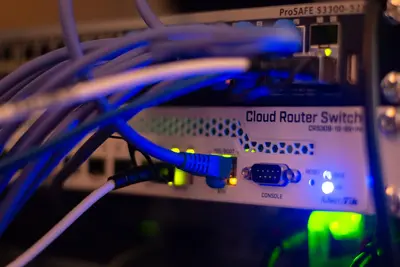🌐 Configuring DNS Server: Simple Guide
Want to set up your own DNS server? I’ll show you how to configure DNS easily! 💻 This tutorial makes DNS setup super simple. Even if networking seems scary, you can do this! 😊
🤔 What is a DNS Server?
A DNS server is like a phone book for the internet. It translates website names into computer addresses!
DNS servers provide:
- 🔍 Website name resolution
- ⚡ Faster internet browsing
- 🛡️ Content filtering capabilities
- 🎯 Local network name management
🎯 What You Need
Before we start, you need:
- ✅ Alpine Linux system running
- ✅ Root or sudo permissions
- ✅ Basic understanding of networking
- ✅ About 35 minutes to complete
📋 Step 1: Install DNS Server Software
Set Up BIND DNS Server
Let’s install BIND, the most popular DNS server software. Think of this as getting your phone book system ready! 📞
What we’re doing: Installing and preparing BIND DNS server.
# Update package database
apk update
# Install BIND DNS server
apk add bind bind-tools
# Install additional utilities
apk add dig host nslookup
# Check installation
which named
named -vWhat this does: 📖 Gives you a complete DNS server system.
Example output:
✅ BIND DNS server installed
✅ DNS utilities available
✅ Version: BIND 9.18.xWhat this means: Your system can now provide DNS services! ✅
💡 DNS Server Basics
Tip: BIND is the most widely used DNS server software! 💡
Note: DNS uses port 53 for both TCP and UDP traffic! 🔌
🛠️ Step 2: Configure Basic DNS
Create DNS Configuration
Now let’s set up basic DNS configuration. Think of this as setting up your phone book rules! 📋
What we’re doing: Creating BIND configuration files for DNS service.
# Create configuration directory
mkdir -p /etc/bind
mkdir -p /var/bind/pri
mkdir -p /var/bind/sec
# Create main configuration file
cat > /etc/bind/named.conf << 'EOF'
// Basic BIND configuration
options {
directory "/var/bind";
pid-file "/var/run/named.pid";
// Listen on all interfaces
listen-on { any; };
listen-on-v6 { any; };
// Allow queries from local network
allow-query { localhost; 192.168.0.0/16; 10.0.0.0/8; };
// Forward DNS queries
forwarders {
8.8.8.8;
1.1.1.1;
};
// Security settings
recursion yes;
allow-recursion { localhost; 192.168.0.0/16; 10.0.0.0/8; };
};
// Root hints
zone "." {
type hint;
file "/var/bind/db.root";
};
// Localhost zones
zone "localhost" {
type master;
file "/var/bind/pri/db.localhost";
};
zone "0.0.127.in-addr.arpa" {
type master;
file "/var/bind/pri/db.127";
};
EOF
# Check configuration syntax
named-checkconf /etc/bind/named.confCode explanation:
listen-on: Interfaces to listen onallow-query: Who can make DNS queriesforwarders: Upstream DNS serversrecursion: Enable recursive queries
Expected Output:
✅ Configuration files created
✅ Syntax check passed
✅ Directory structure readyWhat this means: Your DNS server has basic configuration! 🎉
🎮 Let’s Try It!
Time to create DNS zone files and start the server! This is the exciting part! 🎯
What we’re doing: Creating zone files and starting DNS service.
# Download root hints file
wget -O /var/bind/db.root https://www.internic.net/domain/named.root
# Create localhost zone file
cat > /var/bind/pri/db.localhost << 'EOF'
$TTL 3600
@ IN SOA localhost. admin.localhost. (
2023060101 ; Serial
3600 ; Refresh
1800 ; Retry
604800 ; Expire
86400 ; Minimum
)
@ IN NS localhost.
@ IN A 127.0.0.1
EOF
# Create reverse zone file
cat > /var/bind/pri/db.127 << 'EOF'
$TTL 3600
@ IN SOA localhost. admin.localhost. (
2023060101 ; Serial
3600 ; Refresh
1800 ; Retry
604800 ; Expire
86400 ; Minimum
)
@ IN NS localhost.
1 IN PTR localhost.
EOF
# Set correct permissions
chown -R named:named /var/bind
chmod 755 /var/bind
chmod 644 /var/bind/pri/*
# Start DNS service
rc-service named start
rc-update add namedYou should see:
✅ Zone files created successfully
✅ Permissions set correctly
✅ DNS service startedAmazing! Your DNS server is now running! 🌟
📊 DNS Server Commands Table
| Command | Purpose | Example |
|---|---|---|
🔍 dig | Test DNS queries | dig google.com @localhost |
📞 nslookup | Simple DNS lookup | nslookup google.com |
🛠️ named-checkconf | Check config syntax | named-checkconf |
📋 rndc | Control DNS server | rndc reload |
🎮 Practice Time!
Let’s test and configure advanced DNS features:
Example 1: Test DNS Resolution 🟢
What we’re doing: Testing if DNS server resolves names correctly.
# Test local DNS server
dig google.com @localhost
# Test reverse lookup
dig -x 8.8.8.8 @localhost
# Check DNS server is listening
netstat -tulnp | grep :53
# Test with nslookup
nslookup google.com localhost
# Check DNS server logs
tail -f /var/log/messages | grep namedWhat this does: Verifies your DNS server works correctly! 🌟
Example 2: Create Custom Domain 🟡
What we’re doing: Adding a custom local domain to your DNS server.
# Add custom zone to named.conf
cat >> /etc/bind/named.conf << 'EOF'
// Custom local domain
zone "mylocal.net" {
type master;
file "/var/bind/pri/db.mylocal.net";
};
EOF
# Create zone file for custom domain
cat > /var/bind/pri/db.mylocal.net << 'EOF'
$TTL 3600
@ IN SOA ns1.mylocal.net. admin.mylocal.net. (
2023060101 ; Serial
3600 ; Refresh
1800 ; Retry
604800 ; Expire
86400 ; Minimum
)
; Name servers
@ IN NS ns1.mylocal.net.
; A records
ns1 IN A 192.168.1.10
server1 IN A 192.168.1.20
server2 IN A 192.168.1.21
www IN A 192.168.1.30
EOF
# Check zone file syntax
named-checkzone mylocal.net /var/bind/pri/db.mylocal.net
# Reload DNS configuration
rndc reload
# Test custom domain
dig server1.mylocal.net @localhostWhat this does: Creates your own local domain names! 📚
🚨 Fix Common Problems
Problem 1: DNS server not starting ❌
What happened: Configuration errors or permission issues. How to fix it: Check configuration and fix errors!
# Check configuration syntax
named-checkconf /etc/bind/named.conf
# Check zone file syntax
named-checkzone localhost /var/bind/pri/db.localhost
# Check permissions
ls -la /var/bind/
chown -R named:named /var/bind
# Check DNS server logs
tail -20 /var/log/messages | grep named
# Start service with debugging
named -f -g -d 3Problem 2: DNS queries not working ❌
What happened: Firewall blocking or wrong configuration. How to fix it: Check network settings and firewall!
# Check if DNS port is open
netstat -tulnp | grep :53
# Test local connectivity
dig @127.0.0.1 google.com
# Check firewall rules
iptables -L | grep 53
# Allow DNS traffic
iptables -A INPUT -p udp --dport 53 -j ACCEPT
iptables -A INPUT -p tcp --dport 53 -j ACCEPT
# Save firewall rules
/etc/init.d/iptables save
# Restart DNS service
rc-service named restartDon’t worry! DNS setup has many parts but problems are usually simple fixes! 💪
💡 Advanced DNS Tips
- Monitor DNS traffic 📅 - Use logs to watch DNS requests
- Set up secondary DNS 🌱 - Always have backup DNS servers
- Implement DNS security 🤝 - Use DNSSEC for enhanced security
- Regular maintenance 💪 - Update zone files and check logs
✅ Verify DNS Server Works
Let’s make sure everything is working perfectly:
# Check DNS service status
echo "=== DNS Service Status ==="
rc-service named status
# Test DNS resolution
echo "=== DNS Resolution Test ==="
dig google.com @localhost +short
# Check DNS server is listening
echo "=== Port Check ==="
ss -tulnp | grep :53
# Test reverse DNS
echo "=== Reverse DNS Test ==="
dig -x 8.8.8.8 @localhost +short
# Check configuration
echo "=== Configuration Check ==="
named-checkconf && echo "✅ Config OK"
# Show DNS statistics
echo "=== DNS Statistics ==="
rndc stats
cat /var/bind/named.stats | tail -10Good DNS server signs:
✅ DNS service running
✅ Port 53 listening
✅ Queries resolve correctly
✅ Configuration syntax valid🏆 What You Learned
Great job! Now you can:
- ✅ Install BIND DNS server in Alpine Linux
- ✅ Configure basic DNS settings
- ✅ Create DNS zone files
- ✅ Set up custom local domains
- ✅ Test DNS resolution
- ✅ Troubleshoot DNS issues
🎯 What’s Next?
Now you can try:
- 📚 Setting up DNS load balancing
- 🛠️ Implementing DNSSEC security
- 🤝 Creating DNS clustering
- 🌟 Building enterprise DNS infrastructure!
Remember: Every network engineer started with basic DNS setup. You’re building real networking skills! 🎉
Keep practicing and you’ll become a DNS expert! 💫




